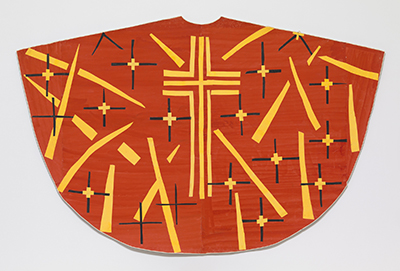Henri Matisse produced this stunning design for the Chapel of the Rosary of the Dominican Nuns of Vence somewhere between the years of 1950-1952. The artist again cut and pasted elements onto flat paper and then glued them in place when he was happy with the final arrangement.
Matisse worked hard to design both the front and back of this chasuble, and the items can now be found within the collection of MoMA in New York, USA. The image displayed here is of the front, with a cross marked out centrally, and further decorative elements spread around the rest of the design. The main background colour here is red, with yellow and black used to deliver the detail. Matisse worked with very limited palettes during this part of his career and this was very much in keeping with the standard approach of most modern artists in the mid 20th century. Impact could be increased in this way, and it also had the advantage of allowing Matisse to just paint a few pages with these tones, before he then cut out the specific shapes. A chasuble is a garment worn by Roman Catholic priests and bishops and some Anglicans during moments of celebration.
Religion and art has long crossed over into each other's realm, going all the way back to the Renaissance artists and indeed many centuries even before that. It can be a way to celebrate elements of religious scripture, but also to help to instill belief within the congregation. Matisse's intentions would tend to have been pure minded, and perhaps a means to modernise fairly traditional clothing. He was very ambitious and open minded in the latter part of his career and liked to tackle different types of content for a variety of patrons. He was someone who wanted to really push himself as far as possible and that included taking on all manner of different challenges, including religious attire as found here with this front and back design for the chasuble.
The artist's highlights included Icarus, The Sheaf and Blue Nude and he would bring about an interest in cut out techniques for the first time within high level professional art. The entry featured here is an interesting alternative, with bright colour, simple detail but also the religious connection. It is therefore correct that it remains on permanent display in MoMA, where it will receive great interest. The venue itself is amongst the most visited galleries in the world, and anything with Matisse's signature will always play a prominent role within the overall display. Matisse here provides an illustration of how modern art can work seamlessly with very traditional content and ideas, so long as the artist is sufficiently skilled.




